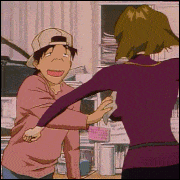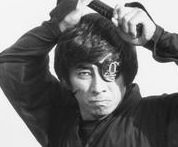|
Has anybody in the thread done traditional Chinese martial arts and practiced iron body/iron vest/golden bell? Iím interested in practicing this teacherís method because he focuses not just on self-beating but also qigong. I know there is some controversy about it but I am a believer that the qigong and self-beating methods are good for you in a way other than just conditioning to withstand blows.
|
|
|
|

|
| # ? May 20, 2024 23:24 |
|
Thirteen Orphans posted:Has anybody in the thread done traditional Chinese martial arts and practiced iron body/iron vest/golden bell? quote:I know there is some controversy about it but I am a believer that the qigong and self-beating methods are good for you in a way other than just conditioning to withstand blows. When older Chinese people go swimming in bodies of water, they slap themselves all over to get blood flowing to help resist the initial sting of getting into the cold water. Itís an unusual tradition, but it has an obvious minor physiological effect. I feel like the instruction you linked is extrapolating pretty hard from basics like more bloodflow and general activity.
|
|
|
|
kimbo305 posted:I trained taijiquan for a while with someone who took the qigong aspects of CMA seriously. The applications I was ever able to develop for that stuff, as I learned it, were extremely few. I appreciate your insight!
|
|
|
|
I took a closer look at the trailer. I feel like I could do most of what he's demonstrating just by tensing my muscles right before the strike -- a habit that's a byproduct of simply doing kickboxing. A bit of extra attention to deadening the nerves (not sure if that's a scientific explanation) and you'd be pretty much there. Getting hit in the ribs seems like a gimmick to me -- they're very strong and even a strong non-trained puncher wouldn't do much against them. You just have to have special training to deal with the pain of getting the knuckles slammed into your skin. The students are striking moderately hard, but not as hard as they could, which is a disappointment again from a fighting perspective. Not enough to impress me, neither in terms of their power to size ratio nor in terms of how much impact they're forcing the teacher to absorb.
|
|
|
|
Our national team went to Coventry, UK for the TKD worlds this weekend. It was pretty small team this time, only something like 8-9 competitors as few took some injuries a couple weeks before they left  Heard last night that we are doing very well out of field of 2000+ competitors. My idol (guy my age) that I thoroughly enjoy training with whenever I can, a late 40s 7th dan, got silver in his exec middle weight category in solo sparring. A guy in one of our sister schools from Ontario got gold in his division for solo sparring (exec heavy) and bronze in patterns which genuinely surprises me as we *never* do well in patterns because we have not drank the ITF sine wave koolaid. 2 of our Junior BBs from my club got silver and bronze in their divisions in sparring. Interestingly, they only seemed to go by weight and had a large age/rank range as they competed against 2nd dan BBs. No injuries yet. Just team sparring left for today which is a ton of fun to watch. In true martial arts fashion, the organizers website is beyond awful with zero news that I can find and  at the idea any video streaming or otherwise, anywhere. at the idea any video streaming or otherwise, anywhere.
|
|
|
|
Is solo vs team sparring what I think it is?
|
|
|
|
After having some doubts about my ability and getting more into BJJ, I am starting to click with it a lot more. I been inconsistent with going to class due self-confidence issues and feeling like I have betrayed my judo (It's a dumb thought, I know). I have been getting out of my comfort zone by stopping myself from going into turtle when a position fails. I been playing around much more with doing sweeps with my hips, attempting to move more from the bottom position. I did find it hard to break some of the bad habits I got into from Judo, but I feel like my grappling have gotten so much better now. I am regularly submitting other white belts as I shake off some of the rust. I was able to outgrip and throw a purple belt recently, Uchimata to Harai Goshi. The guys who were watching me kept telling me the look of pure terror the purple belt had when I had him on my hip. No one started from standing for the rest of the open mat.
|
|
|
|
kimbo305 posted:Is solo vs team sparring what I think it is? I used "solo" as a way to differ from team, but it's a standard 1v1 that AFAIK pretty much all arts do, but unless someone explicitly says team when discussing sparring it's assumed you're talking about either point or continuous 1v1 sparring. So we have point sparring and continuous sparring. Point differs from continuous in that as soon as the ref believes there may have have been a point, he stops the round and polls the judges in the corners. They'll either award a point (or 2) by pointing towards the competitor who they believe scored, or covers their eyes/face with crossed forearms arms to signify no point was seen. The judges *must* clearly see the point with their own eyes. They cannot infer one. If they are facing the backside, they can't award it, even if they hear something or go by the reaction of others. Can't see it with your own 2 eyes, no point. A majority of judges must be in agreement for a point to be awarded, and if differing values are shown the ref with award the smallest. From stopping the action to polling the refs takes between 2-4 seconds tops. It immediately resumes. If there is a tie at the end of the round it usually goes to sudden death and a judge will usually be excused to give it an odd #. In continuous, the round goes non-stop (typically 90 sec-2 minute) with stoppages only for infractions, equipment issues or injuries. Judges have counters in their hand and at the end of the round the ref will poll the judges with who won and the judges will raise their arm with the counter that is the color of the ribbon on the competitor that had the most points. Majority rules. In case of a tie, it goes to a 30 sec overtime round. Sometimes to first point sudden death (depending on the tournament rules). Sidenote: Judges actual individual scores are confidential and not to be shared with anyone unless the ref specifically asks to see them. Team generally operate with point sparring, but I think we have done it as continuous in the club. Not sure if they ever do that in competition or not though.. I don't think so. It follows the point rules for scoring, BUT there is typically a team of 3 competitors on each team and at any pause of sparring (ie: Infraction, polling for points) the coach can swap a competitor. It's a ton of fun both for competitors and spectators and definitely keeps the opponents more fresh.
|
|
|
|
Team sparring in the form of like a 5v5 brawl sounds unsafe but really fun to watch imo
|
|
|
|
Termyie posted:I did find it hard to break some of the bad habits I got into from Judo Bad habits for the judo ruleset, or as translated to doing BJJ?
|
|
|
|
OctaMurk posted:Team sparring in the form of like a 5v5 brawl sounds unsafe but really fun to watch imo I might not have been clear in my reply but in team it is still just 1v1, but the coach just subs in a different team member based on ~reasons~ It is often just simple energy/stamina but also strategy based on who the specific opponent is. Of course, the other team will do the same thing as soon as possible. It's not a royal rumble but it certainly keeps the energy and pace up though. That said, part of our black belt testing for sparring we will usually do group of 3 or 4 all for themselves for a minute or so. We also always do a 2v1 for 60-90 seconds that can be fun to watch. Although that's usually one of the last things and the candidates are doing so they'll be gassed by then, so it often turns into survival. A whole lot moving around the floor and keeping away from the 2 fresh opponents... so a lot of avoiding the corner or getting stuck in the middle.
|
|
|
|
kimbo305 posted:Bad habits for the judo ruleset, or as translated to doing BJJ? A bit of both. Judo's ruleset pushes heavyweights to just defend from turtle on a failed move/throw. Doing it in BJJ just allows people to take my back and reek havoc. It was my go to move when I failed to transition all the time, and it is ineffective against someone who knows how to break people down because BJJ lets people cook. Judo's stoppage for a lack of progress just encouraged it more and more. Also learning to do chokes and joint locks again was hard since I was used to doing pindowns as my primary submission. There is a lot more flexibility to approach situations in BJJ that Judo does not have since it is not illegal to attack legs, shoulder lock, etc that I need to stop worrying about since it is allowed in BJJ. The BJJ club I am with is much better teaching fundamentals than my old Judo Club was. Judo only did a week of basic stuff with you, then the black belts expected you to jump into the deep end with the rest of the colored belts. I always felt like there were some basics that I did not get the grasp of but there was no time to review because there was a intense focus on competition. Anything I did not understand or failed to do, I was just told to turtle. At this BJJ club, even though I have grappling experience, they know I am really out of shape and out of practice so the instructors let me go at a pace that is challenging but not too much that I can't move the next day. It gives me more room to translate Judo into BJJ but also to take in the lessons that are being taught as well. There is a psychological aspect as well. Being a White belt again makes me feel like I can have fun with it and not have to stick to a dogma that my Judo Coaches would make me do when i fought. I also had a lot of mental health issues when I was doing Judo that greatly affected my ability to perform well. Now that I am going to the gym, building myself better, I have a better sense of myself when I am practicing and going to class.
|
|
|
|
slidebite posted:I might not have been clear in my reply but in team it is still just 1v1, but the coach just subs in a different team member based on ~reasons~ It is often just simple energy/stamina but also strategy based on who the specific opponent is. Of course, the other team will do the same thing as soon as possible. It's not a royal rumble but it certainly keeps the energy and pace up though. Can people be subbed in/out without limit? Same length and rounds?
|
|
|
|
You're making me think. I believe no limit so on sub (although there is a practical) and longer/more rounds. I've only personally attended 2 tournaments that had team sparring and I *don't think* there were limits/mandates on individual time other than I think everyone needed to spar, not that it was ever an issue... but I don't know if there is a rule that stipulates time keeping per competitor. Pretty confident the ones that I went to had nobody watching a clock when someone stepped in/out so I doubt it. I guess you could have 1 fantastic athlete do 90% of the competition and 2 mediocre people do 10% but that would be kinda weird and really suck if Capt. Awesome got DQ'd or hurt. I think there were more and longer rounds. Going by memory... 3x rounds @ 4 or 5 minutes each sounds about right? Now that I think about it, I don't remember if at the tournaments the coaches actually pulled the competitors in/out or if refs just called a switch. Or both. I really don't remember. I know when we do it in class (it's rare) - we have a "coach" per side herd the cats. Either way, it's really fun to watch as a spectator. The energy is always kept high. If you're genuinely curious I can find out. I'm training tomorrow with the guy who was the director of our last semi big tournament and he'd know.
|
|
|
|
So I think I got my throat mildly bruised by an excited person doing a rear chokehold a bit too sincerely and even though I tapped immediately (because this wasn't the point of what we were learning), a sharp pain went through my neck and it hurts when I swallow. Yay! I realize from a bit of reading that it's just a bruise but it feels exactly like a sore throat you get from throat-related sickness. My question is: how do you treat/lessen the pain of/accelerate the healing of a bruised/sore throat from combat? I work in phone-related customer support so I have lengthy phone conversations and I know this will suck to continue having, so I'd like to get over this as soon as possible.
|
|
|
|
I've been enjoying Muay Thai and probably will be sticking with it. I don't plan on ever seriously competing, it's mostly a fitness thing for me. I'd like more places to learn about techniques and the cultural and historical context of the sport but also don't want to wade into the toxic cesspit that can be MMA social media. Are their any YouTube channels or social media channels or websites the thread would recommend following?
|
|
|
|
Soylent Pudding posted:I've been enjoying Muay Thai and probably will be sticking with it. I don't plan on ever seriously competing, it's mostly a fitness thing for me. Replace "Muay Thai" with "Brazilian Jiu-Jitsu" and  buddy. buddy.
|
|
|
|
The introduction to Renzo's book has a pretty good history of bjj. Written by danaher before he was famous.
|
|
|
|
Xguard86 posted:The introduction to Renzo's book has a pretty good history of bjj. Written by danaher before he was famous. How's that book overall? Does it get all insano like Rickson's does?
|
|
|
|
After the intro it's all pretty down the middle bjj and vale Tudo techniques. I guess it's kind of weird because there's basically two books jammed into one
|
|
|
|
Xguard86 posted:After the intro it's all pretty down the middle bjj and vale Tudo techniques. I guess it's kind of weird because there's basically two books jammed into one Oh, huh, I may have to check that out. I *should* probably actually read Rickson's as well for the comedy.
|
|
|
|
EdsTeioh posted:Oh, huh, I may have to check that out. I *should* probably actually read Rickson's as well for the comedy. I have the Danaher/Renzo book, it's fine. Don't read Rickson's book, just read bocot's twitter thread with all the good bits. Excerpt here: https://twitter.com/boco_t/status/1661459539273691139
|
|
|
|
Still doesn't measure up to Matt Hughes book. Source of my AV
|
|
|
|
Soylent Pudding posted:I'd like more places to learn about techniques and the cultural and historical context of the sport These are two entry level articles that cover a lot of the same ground: https://sumaleeboxinggym.com/a-history-of-muay-thai/ https://southeastasiabackpacker.com/muay-thai-history/ The latter has this interesting video recounting the legend of Nai Khanomtom. https://www.youtube.com/watch?v=0_Lw8NmuZHI Little details in that ad like how historical Burmese dress is typified is fascinating to me. Muay Boran and Muay Thai are essential to the national mythos of Thailand, and I think that's grounded in the Burma-Siam wars, which carried on for 250 years. One person winning some fights in front of a king is really a footnote in the depth of the conflict. https://en.wikipedia.org/wiki/Burmese%E2%80%93Siamese_wars I think it's impossible to separate Thai culture from the history of these wars.
|
|
|
|
Morter posted:So I think I got my throat mildly bruised by an excited person doing a rear chokehold a bit too sincerely and even though I tapped immediately (because this wasn't the point of what we were learning), a sharp pain went through my neck and it hurts when I swallow. Yay! Cool and warm compresses, and warm drinks, will help soothe the pain, like any other bruised part of the body. Just be gentle with the temperature to start with. Try to take an OTC anti inflammatory if you can tolerate them, which should take any swelling down and help the pain. There's a lot of tissues packed in tightly in the neck, and any swelling will hurt more than you'd expect. I used to get a lot of mild windpipe and jaw bruises from chokes, and a warm washcloth on the front of my neck while I watched TV helped a lot.
|
|
|
|
kimbo305 posted:Can people be subbed in/out without limit? Same length and rounds? So there are 2 types (with rule sets varying to some degree depending on who is hosting the tournament). One is a 5 person team made up of 5 different weight classes, and as the round progresses they'll swap out so its the same class vs class. The other is where there will be 3-5 per team and typically coached. May or may not be same size but in tournaments they will all be a similar rank class. Also I was corrected that continuous is more common than point.
|
|
|
|
butros posted:I have the Danaher/Renzo book, it's fine. Brother, you're not making me *NOT* want to read this
|
|
|
|
drat I hate the gracie family. But on the other hand, it makes me love Sakuraba even more!
|
|
|
|
Jack B Nimble posted:drat I hate the gracie family. But on the other hand, it makes me love Sakuraba even more! For real. I wish that "in a world of Gracies, be a Sakuraba" shirt came in a rash guard.
|
|
|
|
I been doing no-gi beginner's class and I do see why people like it. It is much more challenging than GI in some regards, but I like how I had to figure out how to get in for o-goshi to get people on the ground. I noticed that most BJJ guys want to clinch up when you grapple them which makes them great targets for hip throws. I do feel kinda bad when I counter their throws because they do not see it coming and they go flying when I do it. Then I got my rear end kicked by a girl with insane flexiablity. 10/10, going to do it again.
|
|
|
|
Not BJJ obviously but I love sparring with women that are comfortable sparring and not scared of anything. It's different than most guys.. or maybe more similar to smaller guys that know enough to change their technique so they can use whatever they have in their toolbox to their advantage. A lot of the bigger guys like me typically go almost more toe-toe and slug it out. People that are smaller but flexible learn to be quick, in and out and do more fancy spinning/reverse techniques because it works for them. A bigger guy like me can do a reverse technique on someone who doesn't know to spar and take them totally by surprise, but someone who is experienced,faster, expecting it and looking for the tells/telegraphs is much, much harder to surprise with a technique that takes a fraction of a second longer.
|
|
|
|
More random notes from coaching: For the first time in a looong while, I had a new student join who really really had trouble following instruction. Not in any sort of aggressive, I want to do it differently to hurt someone more way, just bad at executing the steps I laid out, that I then broke down into smaller substeps. They would do things out of order and very frequently relapse into mistakes that I tried to correct them on. They seemed reasonably fit and of at least average strength, but even like clenching jaws and grunting through the moves, that muscle effort never made it to the grabbing and pulling and stepping motions I was walking them through. My concerns in decreasing order: - spending too much time on one student to the exclusing of observing/giving feedback to other students - students who get partnered up and feeling like they're not getting effective drilling from bad partner technique as well as slower pace/workrate - the slow student getting discouraged and not sticking it out While martial arts aren't for everyone in a variety of ways, I certainly hope prospective students don't give up after only one class. I dunno how many lurkers have this fear about their trying something out, but I would say to you, keep showing up for at least a few classes and let it be the coaches' problem how to divide their time. I'm the sanshou coach at the gym, and thanks to having a preschooler at home, I try to be very prudent with my time away at night. One night a week of coaching is a solid commit for me, and so my level 1 and level 2 classes are back to back. My class sizes have stayed small partly cuz what the hell is sanshou, and because students who might otherwise be interested over whatever their schedule is never got a chance to try it out on a more favorable night. Starting out, there were very few people with prior striking experience, so everyone was Level 1. I'm completely in charge of Level 2 standards, and I saw the prereqs as having reasonable kicks and being ready for limited/light head contact. And shinguards, mouthguards, headgear for that equipment cost hit. I invited 2 of the students progressing the fastest, and I was glad they had their plateaus lifted, and didn't have to hold back in certain drills. Another student asked if they were ready, and even though I thought the standards were a bit high for him, I thought he'd benefit from jumping in. This is a guy who's doing 3 classes in a row -- gi BJJ, sanshou, no-gi [now swapping to sanshou L2]. One of the L2 guys is also in L1, and a regular partner to the new student. And they like working together. So there was a lot of synergy when they could pair up again in L2. This is a facet I'd never considered before -- class composition in terms of specific students who show enthusiasm, who're pleasant to partner with -- that can elevate the experience of the whole class. Not that L2 was bad before, but I think everyone including me was more excited to do it with the new guy coming up. Last night, it was just the new guy, so we did some fundamental footwork drills and then escalated to limited rules sparring. My one night of coaching is the most intensive by far workout of the week, and man, I'm way too old to just jump into some light sparring. I need to build up to it on off days just so I can do what I need to show them to demonstrate sound tactics, reasonable form, etc. etc. Also, I got jabbed only several times, all moderate, but I definitely felt it. It really sucks to admit, but my chin is way affected by all the years of sparring. I definitely think about that in terms of possible future CTE progression.
|
|
|
|
kimbo305 posted:who're pleasant to partner with. So, this is one aspect that's highly emphasized as you get more experienced in kendo. How to be a good motodachi (partner). Typically, as a more senior person, you're expected to adjust distance, present timing, pressure, etc, to both make them strike at the right time and distance, but also put a decent amount of pressure of them. It's very important, because if people practice hitting at the wrong distance/timing/etc, that's exactly what they become good at: Doing it wrong. At the same time, it's also very easy to fall into the bossy sensei/senior trap and shout gruff corrections, but a good motodachi will adjust distance without the partner noticing, provide minor hints to what they're lacking and in general make the partner feel good about their practice. (And then if they're slacking off or going too hard, beat the crap out of them). There's nothing worse practicing with a senior who then rejects all your strikes, without providing any kind of feedback.
|
|
|
|
kimbo305 posted:
I hope this doesn't come off as weird self deprecation: this feels like my experience learning. I need significantly more reps and observations to internalize something than my peers typically do. What my instructors tend to do, and I really appreciate this, is focus on one specific thing I'm doing wrong, because more than that and I'm not going to progress on any of them, and they'll be spending a disproportionate amount of time instructing me. I also am beginning to really appreciate how kendo tells beginners to always fall back on the more fundamental technique if they are not 100% ready. Maybe this is tough to apply to empty-hand arts with a relatively large number of basic techniques, though. ImplicitAssembler posted:So, this is one aspect that's highly emphasized as you get more experienced in kendo. How to be a good motodachi (partner). I've had my men on for like a month and it's been a trip having a new "hardest part" of kendo, even just as a junior rotating motodachi in basics practice. Everybody has different sized arms and legs you really can't fall asleep receiving.
|
|
|
|
kimbo305 posted:My concerns in decreasing order: Barring something unforeseen, we always have 2 instructors, a primary and assistant in each class. So the assistant might take more time with a new(ish) student if the primary is spending a lot with a newish student or something that needs lots of help... or sometimes it will be a generic BB that will step up without even being asked (or sometimes volun-told) to help out if there is more than 1. If you are a solo instructor with no help that's tough. Do you have primary/assistant instructors for your classes? Or do you have enough qualified people to go around? Competent senior belts? How often to you swap partners during partner work? Do the students pick them themselves or does the instructor? Different arts obviously, but IMHO the first few classes are basically just a wash either way and the student really, really needs to know this. Positive reinforcement, letting them know that literally nobody gets any of this the first couple classes (even if it might not be quite accurate). When they do something that's OK (even if not really, but maybe not terrible) they need to know it, because they feel dumb as hell and little victories can mean a lot. We let people try a few classes no charge before we ask them join because we'd really rather you not join so it's not yet even more pressure. I know you know this, but students are doing something which their body has either never done before, or is completely out of their comfort zone which can screw with even the most basic things until they get into the flow of how things go. The students need to know this too. They might intuitively understand it, but they need to hear it from someone else with a smile.. preferably more than 1 person. It happened to me not long ago, I was looking at someone square in the eyes and say " I want you to get in a stance with your right leg back. Do you understand? Yes? Great!" And then they proceed to put their left leg back. Twice <brainfart> It can be tough and it is the problem of teaching in general, just not martial arts but the physicality makes it that much worse. Explanations/teaching style don't work with everyone. My GM who has been in martial arts for 40+ years, and a school teacher for 30+, is *excellent* at explaining. He understands the body and has honed his explanations for even fairly complex moves in a way that even most people who don't understand martial arts could probably do it. On the other hand, my 8th Dan other master with virtually as much experience just has a harder time explaining things well. But if you have even the basics down and "get what he means" the guy is incredible.
|
|
|
|
slidebite posted:Do you have primary/assistant instructors for your classes? Or do you have enough qualified people to go around? Competent senior belts? quote:How often to you swap partners during partner work? Do the students pick them themselves or does the instructor? I'm definitely ok with more senior students offering advice or feedback on things to their less experienced partners. I do try to overhear what they say to make sure it's not off base, and it never has been. quote:When they do something that's OK (even if not really, but maybe not terrible) they need to know it, because they feel dumb as hell and little victories can mean a lot. quote:It can be tough and it is the problem of teaching in general, just not martial arts but the physicality makes it that much worse. Explanations/teaching style don't work with everyone. I think the transition to teaching was easy for me cuz while I have a very finely honed style and tactical playbook, I was definitely below average in learning moves physically, and had to teach myself more intricate nuances to help make techniques work, which I can directly pass on to students for techniques that I excel at. And in general, I'm pretty observant, so I can offer very specific feedback in terms of positioning/weight/balance to get students to taken their movements from not effective to effective. It's brilliant to see them turn a mental corner in class. When training for competition, I loved watching others spar and taking mental notes on habits/flaws, and when newer people would spar, I would "soft corner" them and give them tactical advice to try to even things out. Like "you have to pressure this guy onto his back foot or he'll eat you alive with potshot punches. Don't flinch up and get under his first punch and punch up at his chest and head and keep pushing. Only get out of there once he puts a thai plum on you." Not every student is that level of coachable (and holding that much faith in you), but it's jaw dropping to get to see specific tactics that you recommended completely change who's got the upper hand in a round. I think doing that was really why I wanted to do coaching. Ohtori Akio posted:Maybe this is tough to apply to empty-hand arts with a relatively large number of basic techniques, though. Sanshou's throw repertoire is huge, similar to judo's, but same as how many competition judoka have a small set of favorite moves (and a poo poo-ton of misdirects / setups / general awareness), most people get by with a few favored throws/catches, the conditions for which they are good at influencing a fight's trajectory into manifesting. I think it might be too simplified to say to beginning students, "don't worry if you're not good at most techniques; you'll eventually figure out what you're good at and what you want to work on." But I have mentioned before that not every technique suits every body shape or physical limitation, and that you're being exposed to techniques for reasons other that to build you into an optimized fighting machine. To give you a feel for the overall development of the art, and to give you a chance to think more broadly about what's possible in a fight situation.
|
|
|
|
I was this student when I started BJJ. I came in with extremely low body awareness, no history of athletics other than lifting weights, and a number of mobility restrictions. (Took me a month to shrimp properly.) I'm now 4 years in and completely average so I guess it worked out. My first gym was exceptionally unhelpful and the purple belts basically just told me to do the moves harder and I'd figure it out. My current assistant coach does something useful and pops up whenever he sees me straining too hard on a drill and starts asking about what piece is the most hard and to show him. Less words, more demonstrating the specific point of failure. I honestly don't remember why I didn't quit. I felt bad about dragging people down with my flailing, I was embarrassed to keep needing help, but I wanted to do the thing bad enough to where I eventually found a way.
|
|
|
|
kimbo305 posted:No, it's just me. L1 classes are max 8 people, usually 4-6, so frequently very manageable. Obviously, if it's 10, like you, it's generally fairly manageable, but if it's 20+ and a few of them are white belts or, even higher belts but struggling with a technique, it can take a fair amount of hands on assisting which is why we have the "official" assistant instructor each class. Although hell, others will step in on their own and assist for sure.... in adult class at least. In the kids class there will only be 2 instructors and that's it, which they obviously are the ones that are the most time consuming. It's always a fine line, ironically with the kids more than the adults making sure they have good partners. Kind of off topic, but my life would be way easier without having a kids class. But some of them are good little people with a great ethic and you can just tell the want to succeed. Some of our best members are ones that started as kids in the 90s and stayed with it so it would be a disservice to not have a good kids class. kimbo305 posted:My amateur record was 3 losses, one draw, so I never amounted to much as a fighter. But even before I started teaching, I knew I would be way better at it than fighting. Now I'm sure of it. I'm not terribly dissimilar to you and thats totally legit. One of my best friends is a 30 year old female and loathes sparring and has a mediocre record in competition, but she has very good technique, and is very good at explaining. Some of the best coaches in the world in their sports aren't world class athletes themselves... and some of the best athletes make terrible coaches. I think we can all think of examples of both in the various pro sports and other high level competitions. It's a rare breed that is an excellent competitor themselves and also an excellent teacher. quote:When training for competition, I loved watching others spar and taking mental notes on habits/flaws, and when newer people would spar, I would "soft corner" them and give them tactical advice to try to even things out. Like "you have to pressure this guy onto his back foot or he'll eat you alive with potshot punches. Don't flinch up and get under his first punch and punch up at his chest and head and keep pushing. Only get out of there once he puts a thai plum on you." Not every student is that level of coachable (and holding that much faith in you), but it's jaw dropping to get to see specific tactics that you recommended completely change who's got the upper hand in a round. I think doing that was really why I wanted to do coaching. The part that bothers me though is when people are giving advice, and it's actually not great advice... or sometimes outright wrong. ElHuevoGrande posted:I was this student when I started BJJ. I came in with extremely low body awareness, no history of athletics other than lifting weights, and a number of mobility restrictions. (Took me a month to shrimp properly.) I'm now 4 years in and completely average so I guess it worked out. My first gym was exceptionally unhelpful and the purple belts basically just told me to do the moves harder and I'd figure it out. My current assistant coach does something useful and pops up whenever he sees me straining too hard on a drill and starts asking about what piece is the most hard and to show him. Less words, more demonstrating the specific point of failure. I honestly don't remember why I didn't quit. I felt bad about dragging people down with my flailing, I was embarrassed to keep needing help, but I wanted to do the thing bad enough to where I eventually found a way. But, being somewhat tenacious and not giving up means a lot to. Good for you with sticking with it, even if you needed to go to another school. Here is a quote from something I said months ago about an observation my GM gave me. I think it's somewhat relevant here. slidebite posted:So we have a young guy at our club. He's about 12-13 years old, kinda chunky, about as athletic as a corpse and zero sense of balance/coordination. Looks a lot like Chunk from that 80s movie, The Goonies.
|
|
|
|
It took me 10 years to learn how to compete. You can spar all you want, but the moment you step in for real, with real judges, a real opponent (whom you may or may not know), with a crowd watching, it becomes a completely different animal than sparring in the dojo.
|
|
|
|

|
| # ? May 20, 2024 23:24 |
|
I agree that a multi club, large competition is a whole other vibe and can of worms for everyone and it cuts both ways.
|
|
|


























